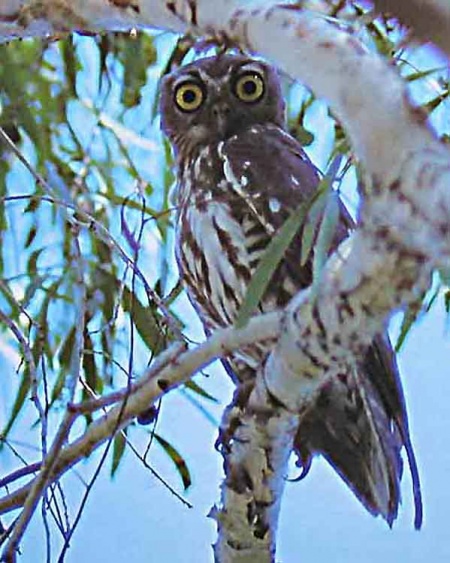- Ninox connivens
Identification
40cm
- Brown plumage
- White spots on wings
- Streaked chest
- Underparts brownish-grey spotted white
- Lighter tail and flight feathers
- Large yellow eyes
- Dark brown beak .
Distribution
Australia and parts of Papua New Guinea.
Taxonomy
Subspecies
Clements recognizes these subspecies[1]:
- N. c. rufostrigata:
- Northern Moluccas (Halmahera, Morotai, Bacan and Obi)
- N. c. remigialis: Kai Besar
- N. c. assimilis:
- Eastern New Guinea, Manam Island and Karkar Island
- N. c. peninsularis (occidentalis):
- Coastal northern Australia and islands in Torres Strait
- N. c. connivens:
Habitat
Lightly timbered open and savannah woodlands, well-forested hill and riverine woodlands.
Behaviour
Diet
The diet includes many types of birds, small possums, bats and rodents, beetles and crickets.
Breeding
The nest is a large hollow high in a tree. The female incubates the 2-3 white, dull, almost spherical eggs for 36 days.
Vocalisation
It sounds like a dog barking or growling, wuf wuf or wuk wuk, or can make a high pitched sound like a female screaming in pain.
References
- Clements, J. F., P. C. Rasmussen, T. S. Schulenberg, M. J. Iliff, T. A. Fredericks, J. A. Gerbracht, D. Lepage, A. Spencer, S. M. Billerman, B. L. Sullivan, and C. L. Wood. 2023. The eBird/Clements checklist of Birds of the World: v2023. Downloaded from https://www.birds.cornell.edu/clementschecklist/download/
- Gill, F, D Donsker, and P Rasmussen (Eds). 2023. IOC World Bird List (v 13.2). Doi 10.14344/IOC.ML.13.2. http://www.worldbirdnames.org/
- The Owl Pages
- Wikipedia
Recommended Citation
- BirdForum Opus contributors. (2025) Barking Owl. In: BirdForum, the forum for wild birds and birding. Retrieved 9 May 2025 from https://www.birdforum.net/opus/Barking_Owl
External Links
GSearch checked for 2020 platform.1





